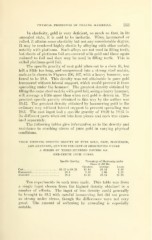Page 497 - My FlipBook
P. 497
PHYSICAL, PROPEETIES 01' FILLING MATliKIALS. 233
In elasticity, gold is very deficient, so much so that, in its
annealed state, it is said to be inelastic. When hammered or
rolled, it attains some elasticity but not any considerable degree.
It may be rendered highly elastic by alloying with other metals,
notably with platinum. Such alloys are not used in filling teeth,
but sheets of platinum foil are covered with gold and these again
reduced to foil and then may be used in filling teeth. This is
called platinum-gold foil.
Tlie specific gravity of cast gold when cut to a close fit, but
left a little too long, and compressed into a strong steel matrix,
such as is shown in Figures 406, 407, with a heavy hammer, was
found to be 19.4. This density was not attainable in pure gold
hammered without lateral support, which would prevent it from
spreading under the hammer. The greatest density obtained by
filling the same steel matrix with gold foil, using a heavy hammer,
will average a little more than when cast gold is driven in. The
greatest specific gravity obtained in this way by the author was
19.42. The greatest density obtained by hammering gold in the
ordinary way without lateral support to prevent spreading was
19.3. The cast ingot had a specific gravity of 19.20 to 19.25 in
its different parts when cut into four pieces and each was exam-
ined separately.
The following tables give information as to the density and
resistance to crushing stress of pure gold in varying physical
conditions.
TABLE SHOWING SPECIFIC GBAVITY OP PURE GOLD, CAST, HAMMERED,
AND ANNEALED, AND THE PER CENT OP SHORTENING UNDER
A STRESS OP THREE HUNDRED POUNDS ON
ONE-TENTH INCH CUBES.
Specific Gravity. Percentage of Sliortening under
Stress of 300 lbs.
Greatest. Average. Least.
Cast 19.22tol9.25 12.16 10.14 8.30
Hammered 19.3 2.52 2.09 1.35
Annealed 19.3 14.41 13.14 12.70
Ten experiments in each were made. This table was from
a single ingot chosen from the highest density obtained in a
number of efforts. The ingot of less density could generally
be brought to 19.3 with careful hammering, but did not prove
as strong under stress, though the differences were not very
great. The amount of softening by annealing is esi^ecially
notable.


